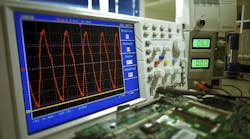With LTE networks being pushed to the forefront of wireless communications by the steadily increasing demand for mobile data access, the market for test equipment that troubleshoots and monitors these networks is expected to reach $6.20 billion in 2021, according to a recent report from Frost & Sullivan, a test equipment research firm.
The LTE test equipment market, which earned revenues of $2.39 billion in 2014, is expected to be lifted by an increasingly complex breed of smartphones, which incorporate multiple built-in antennas that will require longer testing times. Another major boon to the market, the report says, is the growing number and sophistication of wearable technology, including smart watches and personal health bands. Despite low-power requirements, these devices transmit large amounts of rich data that demand the latency and responsiveness of LTE networks.
In addition to testing devices using LTE signals, the report also stressed the widespread demand for testing LTE gateways and access points, especially as the wireless industry transitions from the large cellular base stations that have dominated cellular data for years. The widespread usage of LTE technology can largely be attributed to the ease with which it navigates the HetNet infrastructure.
“While small cells and heterogeneous networks continue to gain momentum as tools that increase mobile network capacity, their quality of service still leaves much room for improvement,” says Olga Yashkova, program manager for Frost & Sullivan analyzing test equipment and the Internet of Things (IoT). Improving that quality of service requires constant testing and monitoring, she adds.
The report comes as wireless companies are in the process of upgrading their LTE infrastructure to address a firmly entrenched expectation for wireless access. At the same time, companies are slowly incorporating the enhanced capabilities of the LTE-Advanced standard, which itself has been described as the bridge to future 5G communications. For instance, it has been designed with enhanced inter-cell resource and interference coordination (eICIC) and terminal receivers with interference cancellation (IC), allowing small cells and macrocells to coexist on the same channel.
Nevertheless, the report notes that LTE test equipment will struggle with the same issues affecting the entire test and measurement industry. On the one hand, the economic downturn has discouraged manufacturers from buying new test systems. On the other hand, the new trend among chipmakers to use manufacturing techniques has heightened costs for test suppliers, the report says.
